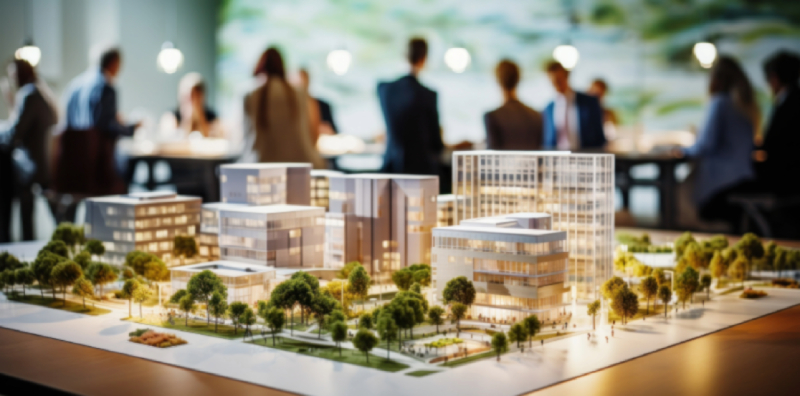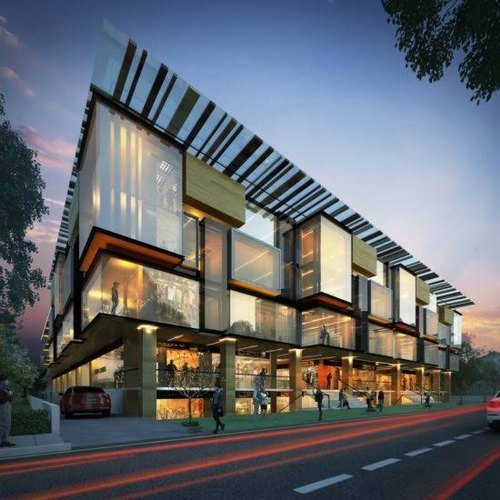Introducing the Comprehensive Services Provided by Commercial Architects for Modern Advancement
Commercial Architects serve an important feature in contemporary advancement projects. They blend style aesthetic appeals with capability while sticking to regulative requirements. Their know-how expands beyond simple building and construction, including sustainable techniques and ingenious innovations. As they browse complex zoning regulations, Architects work together with different stakeholders to bring visions to life. This complex method questions regarding the developing role of Architects in shaping modern rooms and the impact of their work with future advancements.
Understanding the Duty of Commercial Architects in Modern Developments
In modern urban landscapes, Commercial Architects play an important role fit useful and aesthetic areas that meet varied business demands. Their know-how extends past mere style; they browse complex zoning legislations, building codes, and environmental guidelines. By teaming up with clients, they determine details demands, ensuring that each job aligns with the client's vision while also taking into consideration useful elements such as sustainability and cost-effectiveness. Commercial Architects are adept at incorporating innovative modern technologies and products right into their designs, enhancing both the performance and energy performance of buildings. They perform complete site evaluations to examine the prospective challenges and possibilities provided by a place. Furthermore, reliable communication with service providers and other stakeholders is crucial, guaranteeing that the job advances smoothly from perception to completion. Eventually, Commercial Architects contribute in producing rooms that not just meet functional functions but also add to the general character and vibrancy of urban atmospheres.
Idea Style: Changing Ideas Into Fact
Concept design offers as a vital phase in Commercial style, where innovative layout remedies arise from imaginative thinking. This procedure counts on joint ideation, uniting diverse perspectives to improve and boost preliminary concepts. As concepts materialize, they change from abstract notions right into substantial building realities.
Innovative Layout Solutions
Transforming concepts into truth is the trademark of cutting-edge design remedies in Commercial design. These solutions blend imagination with performance, resolving the unique demands of modern growths. By leveraging sophisticated modern technologies and sustainable techniques, Architects craft spaces that are not only visually appealing however additionally effective and adaptable. Emphasis on user experience drives the style procedure, making sure that settings foster efficiency and partnership. Each project advantages from a tailored technique, where ideas are carefully created to reflect the customer's vision while thinking about future trends. Cutting-edge design remedies also prioritize flexibility, permitting alterations over time as company requirements develop. Inevitably, these methods boost the overall worth of Commercial spaces, making them critical in today's affordable landscape.

Collaborative Ideation Process
Cooperation works as the foundation of the ideation procedure in Commercial style, cultivating creativity and development amongst varied stakeholders. Architects, customers, designers, and neighborhood participants involve in dynamic discussions, making certain that all viewpoints are considered. This inclusive technique permits the expedition of different design principles, motivating distinct services that align with the project's vision. Via workshops and conceptualizing sessions, ideas develop and fine-tune, transforming first principles right into concrete layouts. Modern technology additionally plays an essential duty, with tools such as Structure Information Modeling (BIM) helping with real-time partnership and changes. Eventually, this collaborative ideation procedure not only boosts the design end result yet likewise grows a sense of possession and investment among all events included, bring about effective Commercial developments.
Zoning Evaluation: Browsing Rules and Compliance
As designers start on new jobs, recognizing zoning regulations is important to making certain compliance and staying clear of costly delays. Zoning evaluation plays an essential function in this procedure, as it includes examining regional zoning legislations that dictate land usage, constructing height, thickness, and obstacles. Commercial Architects possess the knowledge to browse these intricate regulations, assisting clients determine acceptable usages and any needed differences.
Sustainable Layout Practices: Building for the Future
Sustainable design methods are significantly important in the domain name of Commercial style, particularly as environmental issues continue to rise. Architects focus on environment-friendly products, energy-efficient systems, and layout techniques that lessen waste and ecological effect. Integrating renewable resource resources, such as photovoltaic panels and wind generators, allows structures to create their own power and reduce reliance on fossil fuels.Furthermore, lasting design highlights the importance of indoor environmental top quality. This consists of utilizing natural light, improving ventilation, and selecting safe materials to improve resident wellness and performance. Environment-friendly roofings and living walls are likewise popular features that add to biodiversity and city cooling.Additionally, Commercial Architects frequently incorporate water conservation methods, like rainwater harvesting and drought-resistant landscaping. Through these cutting-edge approaches, they create rooms that not only fulfill contemporary demands yet additionally promote a sustainable future, addressing the discover this info here growing need for accountable development in the contemporary world.
Task Administration: Ensuring Timely and Effective Execution
Efficient project monitoring is vital for making sure that Commercial architecture tasks are finished on time and within budget plan. This function encompasses a series of responsibilities, including the control of various stakeholders, timelines, and sources. Commercial Architects leverage their proficiency to create in-depth project strategies that detail essential turning points and deliverables, permitting methodical progress tracking.Regular interaction amongst employee and customers is essential, cultivating openness and helping with timely decision-making. Risk monitoring methods are also employed to recognize prospective obstacles early, allowing proactive remedies to be established. By utilizing innovative project monitoring tools, Architects can keep an eye on project efficiency in real-time, making adjustments as needed to maintain performance.
Interior Decoration: Creating Practical and Aesthetic Spaces
Inside style plays a crucial duty in boosting both functionality and looks within Commercial areas. Efficient space planning can enhance workflow and enhance individual experience, while aesthetic style principles add to an aesthetically enticing atmosphere - commercial architects. With each other, these aspects produce areas that are not only useful yet likewise inspiring
Area Planning Efficiency
While taking full advantage of the utility of available space, Commercial Architects focus on room preparation effectiveness to produce both practical and cosmetically pleasing settings. This strategy includes careful analysis of the spatial layout to assure ideal use every square foot. Architects consider variables such as operations, access, and all-natural light to improve usability. By strategically positioning furnishings, devices, and workstations, they help with motion and communication among individuals, promoting performance. In addition, zoning various locations for certain functions aids in taking care of sound and privacy, producing a harmonious ambience. Through effective space preparation, Commercial Architects can change restraints into possibilities, making sure that each room meets the diverse needs of its owners while sticking to regulative requirements and sector standards.
Aesthetic Layout Principles
Visual style principles play a vital role in forming atmospheres that are not just practical however additionally visually enticing. These principles guide Commercial Architects in developing spaces that reverberate with individuals while enhancing brand name identification. Trick aspects include equilibrium, proportion, and consistency, which collaborate to create a natural look. Color design and products are thoroughly chosen to stimulate desired feelings and sustain the overall motif. Additionally, lighting plays an essential duty, affecting mood and exposure while highlighting architectural functions. By integrating these principles, Architects guarantee that spaces are not only useful however also inviting and inspiring. Ultimately, efficient aesthetic style promotes a favorable individual experience, motivating interaction and fulfillment in Commercial environments.
Cooperation With Stakeholders: Cultivating Successful Partnerships
Successful collaborations in Commercial style rest on reliable partnership with stakeholders, making sure that every voice is listened to and valued. This joint method involves appealing numerous parties, including clients, specialists, and neighborhood members, throughout the style and advancement process. By cultivating open communication, Commercial Architects can address issues, gather understandings, and line up the job's vision with stakeholder expectations.The integration of varied perspectives boosts imagination and technology, leading to even more functional and aesthetically pleasing styles. Routine meetings, comments sessions, and workshops facilitate this dialogue, enabling Architects to adjust their strategies in feedback to stakeholder input. Additionally, developing depend on through transparency and liability reinforces these collaborations, causing Learn More Here a smoother project execution.Ultimately, the success of modern developments depends on the Architects' capability to navigate and integrate differing passions, developing a collective atmosphere that advertises shared objectives and mutual success.
Often Asked Questions
Just How Do Commercial Architects Deal With Budget Constraints Throughout a Job?

What Types of Software Do Commercial Architects Typically Make Use Of?
Commercial Architects frequently utilize software program such as AutoCAD for drafting, Revit for Structure Information Modeling, SketchUp for 3D modeling, and task monitoring devices like Microsoft Project to improve cooperation and simplify operations throughout the style process.
Can Commercial Architects Aid With Obtaining Funding for Projects?
Commercial Architects can assist in obtaining financing for jobs by preparing thorough propositions, assisting to verbalize design visions, and giving economic forecasts that can boost the likelihood of safeguarding needed funding from capitalists or banks.
Just How Do Architects Make Sure Safety Throughout the Building Refine?
Architects assure safety and security throughout building and construction by executing extensive layout standards, coordinating with engineers, conducting regular site evaluations, sticking to local policies, and promoting communication among all stakeholders to reduce risks and promote a secure workplace.
What Recurring Support Do Architects Provide After Job Conclusion?
After task completion, Architects supply continuous support through upkeep assessments, performance evaluations, and style alterations. They guarantee structures meet progressing demands, address potential issues, and preserve conformity with guidelines, fostering a lasting connection with clients.
Comments on “commercial architects FAQs: Everything You’re Curious About”